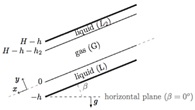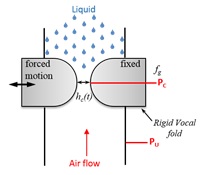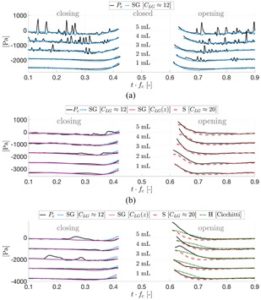Aim
The production of voiced sounds is essentially linked to the auto-oscillation of the vocal folds.
This phenomenon is the result of a fluid-structure interaction between the airflow coming from the lungs and the vocal folds’ elastic tissues (Figure 1). The understanding and modelling of this interaction is crucial for numerous domains from speech synthesis to treatment and voice pathology prevention.
Physical modelling of the vocal folds oscillations requires a biomechanical model of the vocal folds tissues and a model of the flow through the glottis (the glottis is the space between the vocal folds). The theoretical model for the flow determines the hydrodynamic forces imposed on the tissues and is therefore essential for the modelling of the biomechanics. The lubricating role of mucus is known to be crucial, but is not much studied from a physical point of view. The literature also reports that an excess, for example due to bronchial infection, or a rarefaction, due to a dehydrated environment, of the mucus affects the vocal folds vibration and hence perturbs speech production. In addition, the presence of liquids can, potentially, affect the air flow, particularly during the closure of the vocal folds. In this study water/air flow are considered.

Figure 1 : Diagram of the speech production system. Red frame corresponding of the system directly influenced by mucus presence
Theoretical modeling of friction factors in a stratified channel flow
Friction factors and associated friction velocities are important flow characteristics. Analytical expressions of wall and interface friction properties are derived for idealized three layered, nd two layered pressure driven stratified flow in a two-dimensional channel under the assumption of fully developed laminar viscous flow. Channel inclination is accounted for as well. The influence off low and geometrical channel parameters is then concretely assessed for water/air and oil/air interfaces due to their potential relevance to two-phase flows occurring in the human airways.

Figure 2 : Schematic overview of the stratified flow configuration. Gas (G) layer enveloped by two liquid layers (L, L2) of height h and h2 respectively.
Theoretical modeling of mixing fluid air/water flow in the vocal fold constriction based on experimental measurements
The pressure drop for air-water flow within a vertical rigid channel containing a severe time-varying constriction is studied for different forcing frequencies fc ∈ {1, 6, 10} Hz after water (0 up to 5 ml) is injected upstream as shown in Figure 3. The pressure drop at the minimum aperture is observed experimentally and can be modeled with a quasi-steady one-dimensional approach and viscous mixing during the closing and opening phase. It is found that the flow can be regarded as gas dominated during the closing phase. During the opening phase, mixing enhances as fc > 1 Hz, which emphasizes the contribution of water and water droplets to the viscous mixture. Eventually, for fc = 10 Hz and greater water volumes (≥ 3 ml), mixing is further increased so that the flow becomes homogeneous and turbulent during the opening phase. Assessed conditions are relevant to flow through the human glottis.

Figure 3 : Frontal view of experimental setup. Measured signals are liquid injection time tag tL, sprayed liquid volume VL, upstream pressure Pu (t), minimum constriction pressure Pc(t) and minimum constriction opening hc(t).

Figure 4 : Measured Pc (black full) and best model out-comes for VL ∈ {1, 2, 3, 4, 5} ml (shifted for clarity) and fc ∈ {1, 6, 10} Hz, during closing and opening (hc>0) : gas dominated slip model or Chisholm’s constant ≈ 12 (thick dotted) or Chisholm’s constant (z) (gray thin full), slip model for Chisholm’s constant ≈ 20 (thick dashed), and homogenous flow model for Cicchitti parameters (gray thin dashed-dotted) and following Aung (thin dotted). (a) fc= 1 Hz, shifted with 600 Pa; (b) fc= 6 Hz, shifted with 800 Pa; (c) fc= 10 Hz, shifted with 900 Pa.
Measurement analysis of fluid-structure instability of mechanical vocal-folds replicas subjected to water spraying
The influence of surface hydration on the fluid-structure instability underlying vocal folds auto-oscillation during voiced speech sound production is an open research question. In this work, the fluid-structure instability is investigated experimentally using several deformable self-oscillating vocal folds replicas as an example in Figure 5. Changes to auto-oscillation features following water spraying (0 up to 5~mL) (Figure 6) are systematically studied and quantified. For all replicas, it is found that the first harmonic decreases, fluctuations increases and a closing-opening asymmetry is observed. Nevertheless, the degree to which these effects are established depends on the used VF replica so that further systematic investigation is needed to quantify observations as well as to explore underlying mechanisms.

Figure 5 : Frontal view of experimental setup. Measured signals are liquid injection time tag tL, sprayed liquid volume VL and upstream pressure Pu (t).

Figure 6 : Deformable VF replicas measurement shown different of oscillation of the vocal folds with and without water
Bibliography
[1] Van Hirtum A., Bouvet A., Pelorson X., 2018. Friction factors for idealized 2D stratified channel flow. European Journal of Mechanics – B/Fluids, 67:242-248.
[2] Van Hirtum A., Bouvet A., Pelorson X., 2018. Pressure drop for adiabatic air-water flow through a time-varying constriction. Physics of Fluids, 30,1-10.
[3] Bouvet A., Pelorson X., Van Hirtum A., 2018. Fluid-structure instability of mechanical vocal-folds replicas subjected to water spraying: upstream pressure analysis. Submitted.





